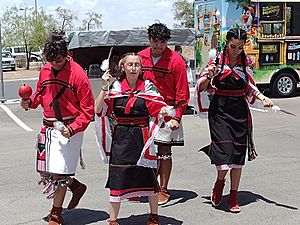Ysleta del Sur Pueblo facts for kids
Quick facts for kids
Ysleta del Sur Pueblo
Tiqua
|
|
|---|---|
|
El Paso
|
|

Young members of Ysleta del Sur Pueblo perform a traditional dance at summer festival, June 2022.
|
|

Location in Texas
|
|
| Sovereign Tribe | Ysleta del Sur Pueblo |
| Country | United States |
| State | Texas |
| County | El Paso |
| Government | |
| • Body | Tribal council |
| Population
(2022)
|
|
| • Total | 400+ |
The Ysleta del Sur Pueblo, also known as Tigua Pueblo, is a Native American Pueblo tribe. They are a federally recognized tribe located in the Ysleta area of El Paso, Texas. Their people are Southern Tiwa speakers. They were moved from Spanish New Mexico between 1680 and 1681. This happened during the Pueblo Revolt against the Spanish.
The people and their language are called Tigua (pronounced tee-wah). They have kept their tribal identity and lands in Texas. In the early 1900s, Spanish mostly replaced their original language. Today, English is becoming more common in the community. However, there are now efforts to bring back their native language.
The Ysleta del Sur Pueblo is one of only three federally recognized tribes in Texas.
Contents
Tribal Government
The Ysleta del Sur Pueblo has its own government. It is led by a Tribal Council. As of 2022, E. Michael Silvas is the Governor of the Pueblo. The Tribal Council helps make decisions for the community.
In 2020, the tribal government provided jobs for 293 people. More than half of these jobs (58 percent) went to tribal citizens.
Population
The number of people who are part of the Ysleta del Sur Pueblo has grown. In April 2008, there were 1,615 enrolled citizens. By 2020, this number had increased to 4,696 enrolled citizens.
Economic Development
For nearly 40 years, the Pueblo has run its own businesses. These businesses create jobs for tribal members and for people in the El Paso area. Some of their businesses include the Big Bear Oil Co., Inc., and the Tigua Indian Cultural Center. They also operate the Speaking Rock Entertainment Center.
The Speaking Rock Entertainment Center is in El Paso. It offers live concerts, a restaurant, a café, and bars. It was first called the Speaking Rock Casino. Since 2022, it has offered Class II casino gaming.
History of the Tigua People
Early Beginnings
The Ysleta del Sur Pueblo is a federally recognized Native American tribe and a sovereign nation. The Tigua community founded Ysleta del Sur in 1682. Before this, the Tigua people left their homes in Quarai Pueblo due to a long drought. They found safety at Isleta Pueblo. Later, the Spanish captured them during the 1680 Pueblo Revolt. They were forced to walk over 400 miles south.
The Tigua people settled and built the Ysleta del Sur Pueblo. Soon after, they built an acequia (canal) system. This system helped them grow crops and build a strong farming community. The tribe's early farming efforts helped the entire region grow and develop.
Life in the 19th Century
Throughout the 1800s, the Tigua people kept their traditional leadership roles. These roles mixed Spanish and Indigenous ways. They had leaders like a Cacique (chief), who served for life, and a Governor. They also had a War Captain and other leaders. Local newspapers often wrote about their tribal elections. They also reported on their main religious celebration, St. Anthony's Day. This day honors St. Anthony, the patron saint of their church.
The Tigua people lived close to their Mexican American neighbors. They often married into Mexican American families. Over time, many Tigua people lost their Tiwa language. They also adopted some customs from their Hispanic neighbors. Despite this, they worked hard to keep their unique identity.
The 20th Century and Recognition
In 1901, a famous anthropologist named Jesse Walter Fewkes visited Ysleta del Sur. He studied the Pueblo people of New Mexico. Fewkes noticed that the Tigua people had adopted some Mexican customs. However, he also wrote about their surviving Pueblo traditions. He found that 25 people could still speak the Tiwa language. Many more could understand it. He noted that the Tigua still performed traditional dances. These dances included a rattle dance with chants in the Tiwa language.
The Tigua people continued to hold elections for their tribal leaders. Fewkes wrote that José Piarote was the Cacique. Mariano Manero was the Governor, and Tomal Granillo was the War Captain. Manero still carried a special staff. This staff was like those carried by leaders in the New Mexico Pueblos. This showed their strong connection to their heritage.
By the 1950s, the Tigua community faced many challenges. They had lost their valuable tribal lands. Most members lived in poverty near the old mission church. Others moved to different parts of El Paso to find better jobs. The City of El Paso annexed Ysleta, which meant new taxes for the community. Tigua leaders asked for help.
In 1961, the Mayor of El Paso wrote to the Bureau of Indian Affairs. He asked for assistance for the Tigua group. However, the U.S. government was ending its support for many tribes at that time. So, they said they were not responsible for the Tigua people.
During the 1960s, the Tigua community worked hard to get help. With the support of a friend, they reached out to a young lawyer named Tom Diamond. Diamond agreed to help them with their economic problems. He also helped the Tigua reconnect with their relatives in Isleta Pueblo, New Mexico. The governor of Isleta Pueblo, Andy Abieta, visited the Tigua. He was surprised by how many Isleta traditions they still kept. He became a strong supporter of the Tigua.
In 1966, Diamond introduced the Tigua to Vine Deloria, Jr. He was a well-known Lakota scholar. Deloria helped the Tigua get recognized as a federally recognized Indian tribe. He also wrote about the Tigua in his famous book, Custer Died for Your Sins. He showed them as a symbol of how Indigenous values survived in modern America.
With help from their supporters, the Tigua gained recognition. In 1967, they were recognized as the Tigua Indians of El Paso. This made them a Texas Indian tribe. In 1968, the United States Congress officially gave responsibility for the Tigua to the State of Texas. This meant they would not get services or claims from the U.S. government as Indians.
Under Texas law, a reservation was created for the Tigua. They started programs to help their economy. A tourism project on the reservation was very important. Tigua people showed their traditional crafts and ways of life. This program was successful for a while. However, it became clear that state aid was not enough. Without federal tribal status, the Tigua could not get federal programs. They could not truly govern themselves.
Finally, on August 16, 1987, a new law was passed. This law restored the federal relationship with the Ysleta Del Sur Pueblo. It also restored the relationship with the Alabama-Coushatta Tribe. The law renamed the tribe to the Ysleta Del Sur Pueblo. It also allowed them to have certain gaming activities. Since 1987, the Tigua have had a continuous federal relationship. This means they can receive services from the federal government.
See also
 In Spanish: Pueblo de Ysleta del Sur para niños
In Spanish: Pueblo de Ysleta del Sur para niños



